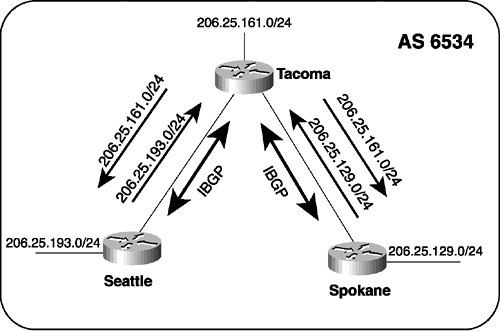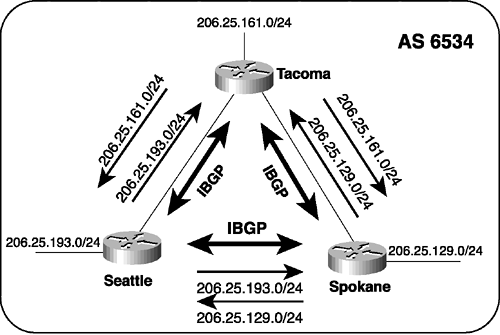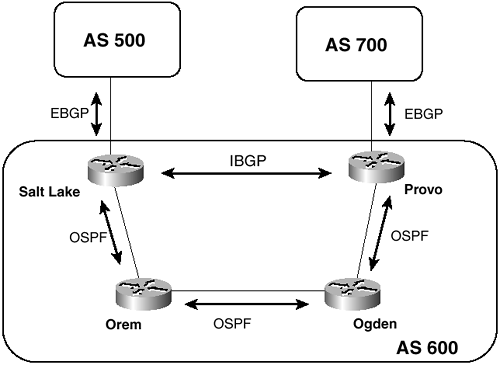IBGP and IGP Synchronization
| With very few exceptions, interior BGP ”BGP between peers in the same AS ”is used only in multihomed scenarios. IBGP allows edge routers to share NLRI and associated attributes, to enforce a systemwide routing policy. IBGP also is the means by which an edge router in a transit AS passes routes learned from an external peer to other edge routers for advertisement to their external peers. You might be tempted to think that in some cases IBGP could be used as an IGP. For instance, an ISP's AS is mostly connected to other autonomous systems by EBGP, and mostly carries transit traffic. Why not run IBGP only within the AS, and have a single consistent routing protocol? The problem is that for full connectivity, every IBGP router must peer with every other IBGP router ”that is, the IBGP internetwork must be fully meshed. This section explains why an IGP is necessary to support IBGP and why synchronization between IGP and IBGP is important. Fully meshed IBGP is used for two reasons:
When routes are advertised via IBGP, they are by definition advertised within the same AS. As a result, the AS_PATH does not change. In fact, the local AS number is not added to the AS_PATH until the route is advertised to an EBGP peer. As a result, the IBGP routes do not have the loop protection that EBGP routes have. To protect against loops, BGP does not advertise routes that have been learned from an IBGP peer to another IBGP peer. Figure 2-32 illustrates what happens when IBGP peers are not fully meshed. Here, IBGP peering sessions have been configured between Seattle and Tacoma and between Tacoma and Spokane. You can see that Seattle and Tacoma are exchanging NLRI about their local networks, as are Spokane and Tacoma. But Seattle and Spokane are not learning each other's NLRI. Figure 2-32. In a Partially Meshed IBGP Environment, Full NLRI Is Not Advertised, Because Routes Learned from One IBGP Peer Are Not Forwarded to Another IBGP Peer Figure 2-33 shows how full reachability is achieved by creating fully meshed IBGP peers. Note that Seattle and Spokane are peers, even though no direct data link exists between them. The TCP session that BGP uses passes through Tacoma but is logically a point-to-point session between Seattle and Spokane. This is an important point, because for the TCP session to be established, Seattle and Spokane must have knowledge of the addresses of the data links interconnecting them. Figure 2-33. In a Fully Meshed IBGP Environment, Every IBGP Router Is Peered with Every Other IBGP Router, and Full NLRI Is Exchanged At first, ensuring that the data link addresses are known seems simple enough ”the addresses at each router must be included in the BGP network statements (discussed in Chapter 3). However, it is not always that simple. Example 2-14 shows Seattle's BGP routing table and its IGP routing table. For the router to forward packets, the destination must be in the IGP routing table. Example 2-14 Although Several Routes Exist in the BGP Routing Table, They Are Not Automatically Entered into the Router's IGP Routing TableSeattle# show ip bgp BGP table version is 7, local router ID is 206.25.193.1 Status codes: s suppressed, * valid, > best, i - internal Origin codes: i - IGP, e - EGP, ? - incomplete Network Next Hop Metric LocPrf Weight Path *> 192.168.1.0 0.0.0.0 0 32768 i * i 192.168.1.1 0 100 0 i *>i192.168.2.0 192.168.1.1 0 100 0 i *>i206.25.161.0 192.168.1.1 0 100 0 i *> 206.25.193.0 0.0.0.0 0 32768 i Seattle# show ip route Codes: C - connected, S - static, I - IGRP, R - RIP, M - mobile, B - BGP D - EIGRP, EX - EIGRP external, O - OSPF, IA - OSPF inter area E1 - OSPF external type 1, E2 - OSPF external type 2, E - EGP i - IS-IS, L1 - IS-IS level-1, L2 - IS-IS level-2, * - candidate default Gateway of last resort is not set C 206.25.193.0 is directly connected, Loopback0 C 192.168.1.0 is directly connected, Serial0 Seattle# As you can see from the output in Example 2-14, the BGP table contains several routes, including the addresses of the Seattle-Tacoma and Spokane-Tacoma data links (192.168.1.0/24 and 192.168.2.0/24). But only Seattle's directly connected links are entered in the IGP routing table. Notice also that Spokane's network 206.25.129.0/24 is not even in the BGP table, indicating that Seattle and Spokane are not peering correctly. NOTE Notice the weight of the directly connected links in the BGP table as compared to the weights of the routes learned from Tacoma. Example 2-14 illustrates the problem of synchronization. The rule of synchronization states the following:
In the internetwork of Figure 2-33, the BGP routes cannot be entered into the IGP routing table because no IGP is running on the routers, and synchronization requires that the routes be known via IGP before they can be entered. To understand why the rule of synchronization exists, consider the network shown in Figure 2-34. In this case, IBGP is not used as the interior gateway protocol. Instead, a legitimate IGP (OSPF) is used. Salt Lake and Provo are connected to two separate autonomous systems, and they advertise the EBGP-learned routes with each other over an IBGP connection. The TCP session for this IBGP connection passes through Orem and Ogden. Figure 2-34. This Internetwork Runs Partially-Meshed IBGP Between Salt Lake and Provo and Uses OSPF as Its IGP Next, suppose Salt Lake learns a route to 196.223.18.0/24 from AS 500 and advertises the route over the IBGP connection to Provo, using a next-hop-self policy to change the NEXT_HOP attribute to its own router ID. Provo then advertises the route to AS 700. Routers in AS 700 now begin forwarding packets destined for 196.223.18.0/24 to Provo. (Remember that a route advertisement is a promise to deliver packets.) Here is where things go wrong. Provo does a route lookup for 196.223.18.0/24 and sees that the network is reachable via Salt Lake. It then does a lookup for Salt Lake's IP address and sees that it is reachable via the next-hop router, Ogden. So the packet destined for 196.223.18.0/24 is forwarded to Ogden. But the external routes are shared between Salt Lake and Provo via IBGP; the OSPF routers have no knowledge of the external routes. Therefore, when the packet is forwarded to Ogden, that router does a route lookup and does not find an entry for 196.223.18.0/24. The router drops the packet and all subsequent packets for that address. Traffic for the network 196.223.18.0/24 is black-holed. Of course, if the OSPF routers in Figure 2-34 know about the external routes, the situation just described will not happen. Ogden will know that 196.223.18.0/24 is reachable via Salt Lake and will forward the packet correctly. Synchronization prevents packets from being black-holed within a transit AS by an IGP with insufficient information. When Provo receives the advertisement for 196.223.18.0/24 from Salt Lake, it adds the route to its BGP table. It then checks its IGP routing table to see whether an entry exists for the route. If not, Provo knows that the route is unknown to the IGP, and it cannot advertise the route. If and when the IGP makes an entry in the routing table for 196.223.18.0/24 (that is, when the IGP knows of the route), Provo's BGP route is synchronized with the IGP route, and the router is free to begin advertising the route to its BGP peers. Returning to the example of Figure 2-33 and Example 2-14, you can now see why synchronization is preventing the fully meshed IBGP from working properly. Tacoma is stuck in a Catch-22. It is receiving routes from Seattle and Spokane, but it cannot enter the routes in its IGP routing table or advertise them, because the routes are not in the IGP routing table already. There is no IGP to put them there. Synchronization is a somewhat antiquated feature of BGP that assumes redistribution of routes into the IGP. As this example shows, however, with fully meshed IBGP, all routers can know all necessary BGP routes through BGP alone. Synchronization, in this case, stands in the way of keeping BGP routes within BGP and using IGP only for establishing IBGP connectivity. Luckily, Cisco routers have the option of disabling synchronization. Example 2-15 shows Seattle's BGP and IGP routing tables after synchronization is turned off. Tacoma has forwarded the routes from Spokane, and packets are forwarded correctly. Example 2-15 Seattle Has Full NLRI In Its BGP and IGP Routing Tables After Synchronization Is Disabled on the Three Routers Shown in Figure 2-33Seattle# show ip bgp BGP table version is 11, local router ID is 206.25.193.1 Status codes: s suppressed, * valid, > best, i - internal Origin codes: i - IGP, e - EGP, ? - incomplete Network Next Hop Metric LocPrf Weight Path *> 192.168.1.0 0.0.0.0 0 32768 i * i 192.168.1.1 0 100 0 i *>i192.168.2.0 192.168.1.1 0 100 0 i * i 192.168.2.1 0 100 0 i *>i206.25.129.0 192.168.2.1 0 100 0 i *>i206.25.161.0 192.168.1.1 0 100 0 i *> 206.25.193.0 0.0.0.0 0 32768 i Seattle# show ip route Codes: C - connected, S - static, I - IGRP, R - RIP, M - mobile, B - BGP D - EIGRP, EX - EIGRP external, O - OSPF, IA - OSPF inter area E1 - OSPF external type 1, E2 - OSPF external type 2, E - EGP i - IS-IS, L1 - IS-IS level-1, L2 - IS-IS level-2, * - candidate default Gateway of last resort is not set C 206.25.193.0 is directly connected, Loopback0 B 206.25.129.0 [200/0] via 192.168.2.1, 00:07:34 C 192.168.1.0 is directly connected, Serial0 B 192.168.2.0 [200/0] via 192.168.1.1, 00:07:42 B 206.25.161.0 [200/0] via 192.168.1.1, 00:07:43 Seattle# ping 206.25.129.1 Type escape sequence to abort. Sending 5, 100-byte ICMP Echos to 206.25.129.1, timeout is 2 seconds: !!!!! Success rate is 100 percent (5/5), round-trip min/avg/max = 4/5/8 ms Seattle# The moral of the story is that for IBGP to work correctly, one of two configuration options must be performed:
Chapter 3 offers several examples of IBGP configurations. It also revisits the drawbacks to the two configuration options and demonstrates some partial solutions to them. |


